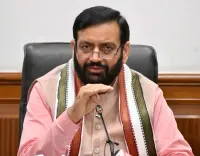Did Rajnath Singh Just Transform UP into a Defence Manufacturing Hub?

Synopsis
Key Takeaways
- Inauguration of the BrahMos missile unit signifies India's defence advancement.
- Facility aims to produce 80-100 BrahMos missiles annually.
- Uttar Pradesh is positioning itself as a key defence manufacturing hub.
- Significant investments in local economy through defence projects.
- Commitment to strengthen national security and self-reliance.
Lucknow, May 11 (NationPress) Defence Minister Rajnath Singh on Sunday inaugurated the BrahMos supersonic cruise missile production facility at the Uttar Pradesh Defence Industrial Corridor in Lucknow, referring to the state-of-the-art missile as a testament to India's escalating defence capabilities and technological advancement.
Singh, who attended the inauguration through video conferencing, noted that the event's timing on National Technology Day holds profound significance.
"On this date in 1998, under the guidance of Atal Bihari Vajpayee, India executed nuclear tests in Pokhran, demonstrating the prowess of our scientists and engineers. This day is dedicated to celebrating their invaluable contributions," he stated.
The newly established manufacturing unit spans over 80 hectares of land generously provided by the Uttar Pradesh government, with completion achieved in a swift 40 months at an investment of Rs 300 crore.
This facility is set to produce between 80 and 100 BrahMos missiles each year, along with an additional 100 to 150 next-generation variants annually.
The BrahMos missile, a product of BrahMos Aerospace—a collaboration between India's DRDO and Russia's NPO Mashinostroyeniya—can engage targets located at a distance of 290 to 400 kilometers and achieves speeds of up to Mach 2.8.
Singh commended the swift development and dedication shown in bringing this project to fruition.
"I extend my congratulations to Uttar Pradesh Chief Minister Yogi Adityanath. This marks a pivotal milestone in transforming UP into a significant hub for defence manufacturing. All six nodes of the corridor—Lucknow, Kanpur, Jhansi, Chitrakoot, Agra, and Aligarh—are poised to evolve into substantial economic and industrial centers," he remarked.
Reflecting on Kanpur's historical industrial prominence, Singh commented, "This region was once dubbed the Manchester of the East. I am optimistic that Kanpur and its neighboring areas will regain their economic prominence. In time, the world will recognize the 'Kanpur of the West.'"
He also mentioned that seven additional strategic projects are in the pipeline, which will further advance India's journey towards defence autonomy.
"BrahMos stands as one of the swiftest supersonic cruise missiles globally. It represents more than just a weapon—it conveys a message. A message of India's strength, deterrence, and steadfast resolve to safeguard its borders," he stated.
Referencing former President A.P.J. Abdul Kalam, Singh added, "Strength commands respect. The world admires the powerful, not the weak."
The Defence Minister drew parallels between the Indo-Russian BrahMos collaboration and the spiritual convergence in Prayagraj.
"Just as Prayagraj is famed for its sacred meeting point, Lucknow will now be distinguished for this technological convergence that melds the finest of Indian and Russian defence capabilities," he expressed.
Officials indicated that the next-generation BrahMos missile will weigh 1,290 kilograms—less than half the current weight of 2,900 kilograms—and will boast an expanded range exceeding 300 kilometers. This advancement will allow fighter aircraft such as the Sukhoi to carry multiple missiles instead of just one.
Alongside the manufacturing unit, the Aerospace Integration and Testing Facility was also inaugurated, where assembly and testing of the missiles will occur.
Additionally, the Titanium and Super Alloys Materials Plant (Strategic Materials Technology Complex), aimed at producing vital materials for aerospace and defence, was launched.
Moreover, the foundation stone for the Defence Testing Infrastructure System (DTIS) was laid, intended to function as a dedicated center for testing and certifying defence equipment.
The Uttar Pradesh Defence Industrial Corridor, unveiled by Prime Minister Narendra Modi during the 2018 Global Investors' Summit, aspires to attract significant defence investments and propel India towards self-sufficiency in military production.
Uttar Pradesh is the second state, following Tamil Nadu, to establish such a corridor, further solidifying its role in India's national security framework.







